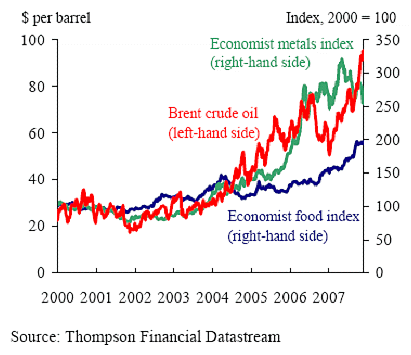1929:
All the liquidity in the world rushes to the American stock market to partake of margin interest.
Multiple years of underinvestment in low return industries results, similarly multiple years of overinvestment in certain new industries results in overcapacity.
Bursting of the bubble leads to rapid withdrawal (coupled with losses) of liquid capital leading to collapse in overinvested sectors; in turn the underinvested sectors suffer from liquidity crunch.
Overall economy is fatally wounded for a decade.
2007:
All the debt in the world rushes out of America to fulfill desire for risk-free interest return.
Multiple years of overinvestment in debt related industries (residential/commercial real estate, corporate finance/buyback shenanigans, M & A, hedge fund multipliers, etc), coupled with similar time frame underinvestment in US domestic low return sectors (manufacturing, production, 'day to day' services).
Bursting of the bubble leads to collapse of debt acceptance (i.e. end of lending).
Overinvested sectors collapse, underinvested sectors also suffer from lack of liquidity.
----------
Since 1929 was due to withdrawal of liquidity, deflation ensues as lack of liquidity forces prices down.
2007 also has a liquidity crunch, however, the underlying mechanism is different in that the liquidity was due to debt creation followed by securitization (vs. attracting hot money via paying margin interest). Thus bursting of this bubble has some deflationary tendencies from normal liquidity crunch, but ultimately the built up debt in the system forces inflation to allow the debt to be written off and/or repaid.
Yes, basically a rewording of Ka-Poom.
All the liquidity in the world rushes to the American stock market to partake of margin interest.
Multiple years of underinvestment in low return industries results, similarly multiple years of overinvestment in certain new industries results in overcapacity.
Bursting of the bubble leads to rapid withdrawal (coupled with losses) of liquid capital leading to collapse in overinvested sectors; in turn the underinvested sectors suffer from liquidity crunch.
Overall economy is fatally wounded for a decade.
2007:
All the debt in the world rushes out of America to fulfill desire for risk-free interest return.
Multiple years of overinvestment in debt related industries (residential/commercial real estate, corporate finance/buyback shenanigans, M & A, hedge fund multipliers, etc), coupled with similar time frame underinvestment in US domestic low return sectors (manufacturing, production, 'day to day' services).
Bursting of the bubble leads to collapse of debt acceptance (i.e. end of lending).
Overinvested sectors collapse, underinvested sectors also suffer from lack of liquidity.
----------
Since 1929 was due to withdrawal of liquidity, deflation ensues as lack of liquidity forces prices down.
2007 also has a liquidity crunch, however, the underlying mechanism is different in that the liquidity was due to debt creation followed by securitization (vs. attracting hot money via paying margin interest). Thus bursting of this bubble has some deflationary tendencies from normal liquidity crunch, but ultimately the built up debt in the system forces inflation to allow the debt to be written off and/or repaid.
Yes, basically a rewording of Ka-Poom.


Comment